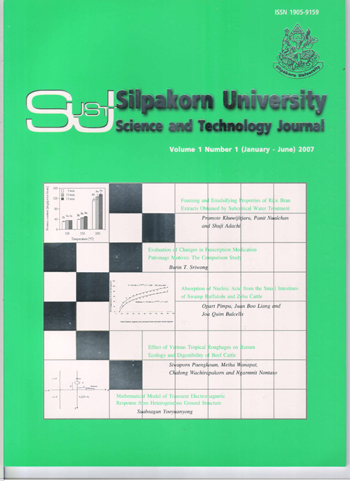Foaming and Emulsifying Properties of Rice Bran Extracts Obtained by Subcritical Water Treatment
Main Article Content
Abstract
Rice bran, a by-product from rice milling process, contains a number of valuable components that imparteither functionality or nutritive value. This study explored the properties of rice bran extract that obtained bytreating the defatted rice bran with subcritical water at different temperatures (100, 150 and 200°C) and times (5,10 and 15 min) in a batch-type vessel. The liquid extracts were analyzed for a protein content, foaming activity and emulsifying and emulsion stabilizing activities. We found that increasing the treatment temperature increasedall of those values. Although treatment time affected trivially on those properties, long treatment time (15 min) at 200°C reduced the foaming activity and emulsion stabilizing activity of the extract significantly.
Downloads
Article Details
References
Cheruvanky, R. (2003). Phytochemical products: ricebran. In Phytochemical functional foods (Johnson, I. T., and Williamson, G., eds), pp. 347-376. CRC Press; Woodhead Publishing, Boca Raton; Cambridge.
Holliday, R. L., King, J. W. and List, G. R. (1997). Hydrolysis of vegetable oils in sub - and supercritical water. Industrial & Engineering Chemistry Research, 36(3): 932-935.
Lawal, O. S. and Adebowale, K. O. (2006). The acylated protein derivatives of Canavalia ensiformis (jack bean): A study of functional characteristics. LWT-Food Science and Technology, 39(8): 918-929.
Neter, J., Wasserman, W. and Kutner, M. H. (1990). Applied linear statistical models, Richard D. Irwin, Inc., Illinois.
Panyam, D. and Kilara, A. (1996). Enhancing the functionality of food proteins by enzymatic modification. Trends in Food Science & Technology, 7(4): 120-125.
Parrado, J., Miramontes, E., Jover, M., Gutierrez, J. F., Collantes de Teran, L. and Bautista, J.(2006) Preparation of a rice bran enzymatic extract with potential use as functional food. Food Chemistry, 98(4): 742-748.
Pinto, J. S. S. and Lancas, F. M. (2006). Hydrolysis of corn oil using subcritical water. Journal of the Brazilian Chemical Society, 17(1): 85-89.
R Development Core Team (2006). R: A language and environment for statistical computing, R Foundation for Statistical Computing, Vienna, Austria. ISBN 3-900051-07-0, URL http://www.R-project.org.
Sasaki, M., Kabyemela, B., Malaluan, R., Hirose, S., Takeda, N., Adschiri, T. and Arai, K. (1998). Cellulose hydrolysis in subcritical and supercritical water. Journal of Supercritical Fluids, 13(1-3): 261-268.
Sereewatthanawut, I., Prapintip, S., Watchiraruji, K., Goto, M., Sasaki, M. and Shotipruk, A. Extraction of protein and amino acids from deoiled rice bran by subcritical water hydrolysis. Bioresource Technology (in press).
Tuncturk, Y. and Zorba, O. (2006). The effects of enzymatic hydrolysis of casein on apparent yield stress and some emulsion properties. Food Hydrocolloids, 20(4): 475-482.
Uruakpa, F. O. and Arntfield, S. D. (2005). Emulsifying characteristics of commercial canola protein-hydrocolloid systems. Food Research International, 38(6): 659-672.
Wakita, Y., Harada, O., Kuwata, M., Fujimura, T., Yamada, T., Suzuki, M. and Tsuji, K. (2004). Preparation of subcritical water-treated okara and its effect on blood pressure in spontaneously hypertensive rats. Food Science and Technology Research, 10(2): 164-167.
Wiboonsirikul, J., Hata, S., Tsuno, T., Kimura, Y. and Adachi, S. Production of functional substances from black rice bran by its treatment in subcritical water. LWT - Food Science and Technology (in press).
Wrolstad, R. E. (2005). Handbook of food analytical chemistry, Wiley-Interscience, Hoboken, N.J.
Yoshida, H., Terashima, M. and Takahashi, Y. (1999). Production of organic acids and amino acids from fish meat by sub-critical water hydrolysis. Biotechnology Progress, 15(6): 1090-1094.


